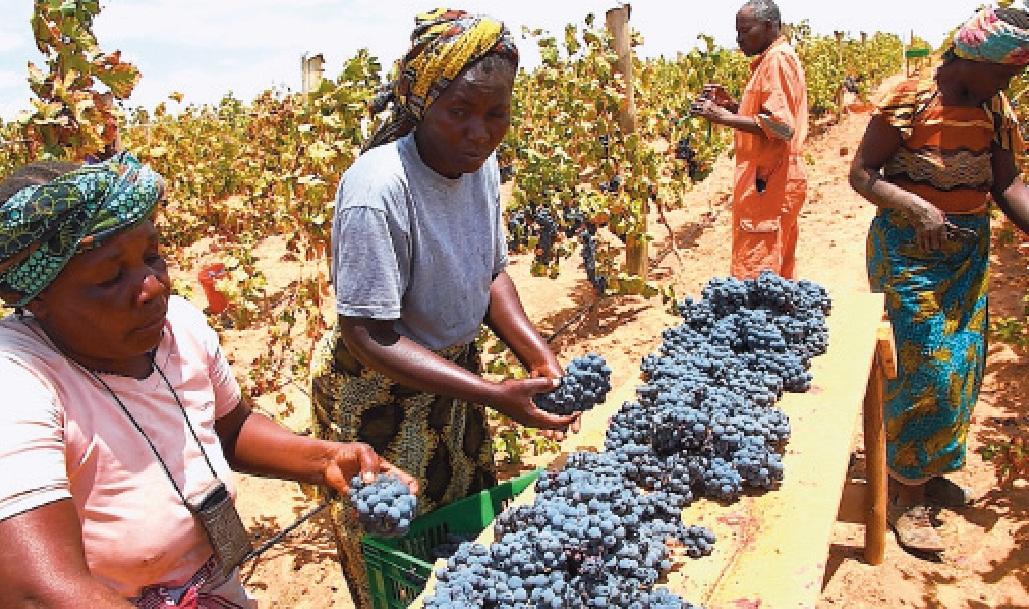Africa-Press – Tanzania. For many people, if you mention Dodoma, a picture of ripe, succulent grapes comes into their minds, while to others the image of sparkling wine will dominate their consciousness.
Getting an opportunity to visit grapes farmers in Dodoma, then it will only be normal if one gets tempted to make all the efforts to become a successful producer of wine, especially after the government has invested a lot to ensure that the crop is successful.
It is this interest in how Dodoma Region has become famous worldwide in producing world class wine that prompted the writer to dig deep into the whole process of producing wine, especially after learning that a vineyard can produce grapes 70 years after the first harvest.
TARI Makutupora Centre in Dodoma boasts of having a wide selection of grape types in the vineyard nursery, with some of the grape types that have existed for over 40 years but are still producing excellent grapes, becoming the oldest grapevines in the country, which is used to train farmers.
TARI-Makutupora Centre is mandated to research grape crops at the national level to assist farmers and other grape stakeholders to increase productivity.
Researchers at the Centre research grapes to bring findings that address problems of farmers’ and processors’ in the country.
The Centre is responsible to research value addition to minimize post-harvest losses which are common in grapefruits as a perishable crop in nature.
Not only that but TARI Makutupora trains farmers on the processing of the grapes.
Speaking to TARI Makutupora Centre Director, Dr Cornel Massawe, said apart from the responsibility of researching the best varieties of grapes, they are also responsible for collecting information, classifying, evaluating and disseminating the best grape technology.
He points out that the first and most important technology is to have the best varieties that are resistant to disease and drought tolerant, although grapes do not require much rain and in the end, the development of the varieties are tailored to the needs of the customers.
Just like other crops, he says that grapes need to be planted using the right spacing to optimize plant population which in the end will reward the farmer with a bumper harvest.
Vineyard preparation:
TARI experts and researchers delved into the whole secret and steps that a farmer has to follow to get a good, abundant and optimum yield and be able to increase production.
To get a good and productive crop, the experts say that the farmer has to plant in soils that have been researched and are suitable for growing grapes.
In Tanzania, TARI has identified some areas suitable for growing grapes, which are Dodoma, Morogoro, Kilimanjaro, Tanga, Babati, Karatu, Tabora, Bunda, and Peramiho. Dodoma produces the best high-sugar grapes that are needed for wine.
Explaining the process of preparations and maintenance of a vineyard, Dr Massawe said that the area which is suitable for grape cultivation is supposed to be well-drained.
He said that the farmer is required to prepare the field for ploughing by cultivating ridges at a distance of 2.5 meters between one row and the other, with a trench for composting.
The expert further said that after cleaning the farm, the field is measured using foot ropes for making the trenches, and the height of the trenches depends on the size of the field.
Experts recommend that every single terrace be fertilized with 3 tons of manure for a 64 –meter long terrace that will be sustainable for five years before it is replenished.
After digging ditches or holes in the vineyard, the farmer is supposed to mix the topsoil with manure in a ratio of 1: 2 (manure: soil) until the hole or trench is filled.
The fertilizer must be mixed well with the soil to speed up the decomposition of the manure and avoid burning the roots of the vines when they reach the compost layer.
Preparation of Seedlings for Planting
After the seedlings are uprooted in the garden, the branches are trimmed, leaving one strong twig with two eyes, and reduce the height of the roots to 5-10 centimetres. The farmer is advised to transplant the seedlings and immediately water them once planted if there is no rain.
Maintaining seedlings in the vineyard
To care for the farm, the farmer should weed and loosen the soil regularly to control grape diseases such as Downy mildew, powdery mildew and pests.
In controlling Downy mildew, a farmer should use Ridomil, Dithane or Mancozeb and when it comes to powdery mildew, one is advised to use Xanthol and Innovex to spray the seedlings. For pest control, a farmer is an adviser to use pesticides such as Selectron, Duduba and Gammalin for ants.
According to Dr Massawe, grapes are creeping plants, so it is important to give them support. The supports can be poles or wires.
The benefits of providing support are to protect the plants against diseases and pests and to facilitate spraying, weeding, pruning and harvesting the grapes in the field and allowing sunlight and air circulation to enter the field easily
Pruning vineyards
The expert said that without pruning the vines, they will not be able to produce fruits. Pruning the grapes is an act of removing branches from the vines. Pruning is done twice a year.
Other benefits of pruning the vineyards include enabling the grape plant to bear fruits, give the vine a good distribution of food, and to give the vine a good shape, remove weak, twisted and diseased branches and reducing the environment for pests and diseases
Procedures of cutting the vines
Leave a height of 2 cm above the last eye, cut a branch and then tie the branch with a rope. Once the eyes have sprouted and released the branches, tie them over a wire or second pole. Prune all the sprouts that grow under the ground wire.







